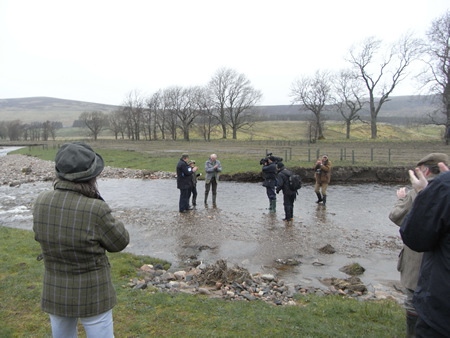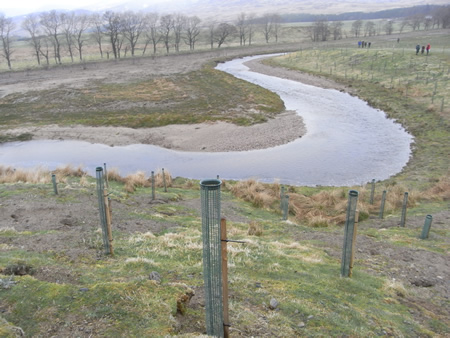These bulletin blogs represent news about Finavon and the South Esk, and my views as a riparian owner. While I may digress at times to write about other places, these are not the views of any other organisation, nor are they designed to promote the interests of any individual or organisation other than Finavon Castle Water and factors affecting the fishery. Tony Andrews
On Friday there was a well attended ‘opening’ of the restored section of the Rottal Burn, from the north Glen Clova road bridge over the Burn down to its confluence with the main stem of the South Esk. Readers of these blogs may remember the report on my first visit to the Rottal Project in September 2012.
The libation. Fiona Armstrong in the company of Dr Marshall Halliday pours whisky into the clear, cold waters of the Rottal Burn marking the end of the first phase of the project. It is likely that some remedial work will be required to prevent the channel taking a new direction. It may prove problematic to keep the channel away from the road and the line of a ditch running parallel to it. It will be interesting to see how this problem is overcome.
Over the winter there have been some big spates, and not surprisingly considerable erosion has taken place along the banks of the newly restored channel. That was to be expected because erosion is a natural process that has been going on in the alluvial sandy plain of the South Esk’s upper catchment since the last ice age. The purpose of the Rottal restoration was to kick-start a regeneration of the burn in the direction it might have evolved, had an eighteenth century farmer and his successors not canalised the stream.
This section of the new channel is a demonstration of what can be achieved by working with natural features and morphology. After a winter of being hammered by big spates the channel has settled beautifully, with depositing zones and scour channels providing a natural sequence of riffle-pool-riffle. Let’s hope it stays that way.
The intervention of modern excavating diggers successfully eradicated the canalised channel, and replaced it with a meander approximating to the course of the burn as revealed by old maps. On the day the work was completed and the last JCB bucket had neatly patted down the loose gravel along the banks of the restored channel, natural processes were unleashed. It was perhaps a bit unlucky that the spates of Decmber 2012 came with exceptional ferocity. The Rottal is a high energy stream anyway, but, with the fury of a ‘force 12’ winter spate, the level of erosion was greater than in a normal year – with resulting changes to the newly made gentle meanders, some of which were outstandingly successful, but unfortunately one particular section which could spoil the project as planned. Had the roots of the bankside vegetation matted down the gravels, and tree roots had time to strengthen the banks before the storms came, it might have resulted in a gentler period of erosion.
I shall return to the Rottal Burn in late June to see how the new channel has settled in after a period of spring growth.
TA 6/5/2013

